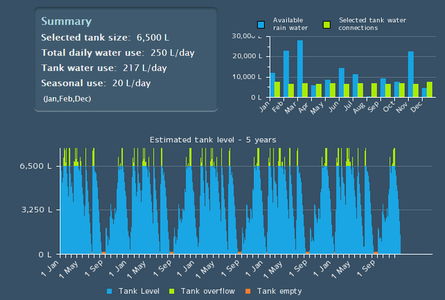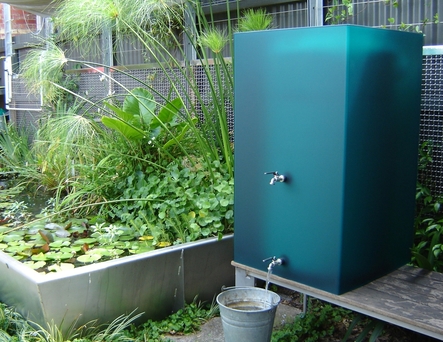How to size your rainwater tank
|
Installing a rainwater harvesting system can reduce mains water use and save you money, but how big does the tank need to be?
|
|
Estimate the average daily rainwater runoff for the chosen roof collection area.
Rainwater roof runoff is calculated as = roof area (sq. meters) x rainfall (mm) Av daily runoff in litres = av. daily rainfall (mm) x roof area (m²) |
Next step is to estimate how much rainwater will be used on average per day in litres/day. eg.
20l/person/day - toilet 3 star WELS 150 l/wash - front loading w/machine 20 l/minute - garden hosing If the whole house will be supplied with rainwater, use the average daily usage from water bills. |
The following rule of thumb guide was developed for Sydney but can be used for other regions where rainfall is on fairly evenly distributed throughout the year.
Note also that doubling the tank size from that target will result in about a 10% higher yield. |
 screenshot of ATA Tankulator screenshot of ATA Tankulator
|
For other regions of Australia probably the best online tool for assessing rainwater harvesting is the Alternative Technology Association's Tankulator.
To use the Tankulator, you will need to sign in with an email address, and then fill out a questionnaire page (which you can always return to and modify). The input needed is similar to above. A default breakdown between all the household water uses will be applied or you can customise them. Once complete, you can run the Tankulator for different tank sizes, uses and rainfall data. |
To find out how we can help reduce your energy bills call John 0418 262706 or email [email protected]
You may also be interested in
|
Solar Power Consultation
Ecological Design offers a complete Solar Power Consultation. We do the measuring, monitoring (if required) and financial modelling using sophisticated tools to select the best solar power system for your needs. Click below to learn more about Solar Power Consultation |
Rainwater Harvesting Design
Ecological Design provides a premium rainwater harvesting system design service. We have designed rain-harvesting solutions for projects ranging from straight-forward small domestic systems to the rainwater supply for a large meditation centre. Click below to learn more about Rainwater Harvesting Design |
Home Sustainability Consultation
At Ecological Design we realise that each home is unique in both challenges and opportunities. We are able to make pragmatic recommendations that will both save you money and make your home more comfortable. Click below to learn more about Home Sustainability Consultation |











